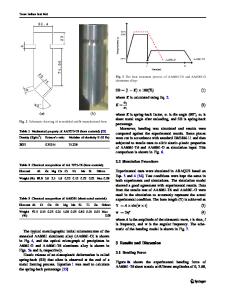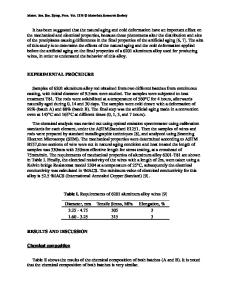Effect of cold rolling on the indentation deformation of AA6061 aluminum alloy
- PDF / 444,722 Bytes
- 8 Pages / 612 x 792 pts (letter) Page_size
- 88 Downloads / 342 Views
The indentation behavior of cold-rolled AA6061 Al alloy was investigated. Following the approach suggested by Tabor, indentation stress–indentation strain curves were constructed and analyzed. The indentation stress required to create the same indentation strain increases with an increase in the reduction of thickness, suggesting a strong effect of plastic deformation history on the deformation behavior of materials. Through the dislocation dynamics, the evolution of the dislocations underneath the indentation was correlated with the plastic deformation history and the indentation load. The plastic energy dissipated in indentation was then calculated and found to be proportional to the 3/2 power of the indentation load and the 3/4 power of the average dislocation density underneath the indentation. The ratio of the dissipated plastic energy to the total energy in the indentation was demonstrated to be a function of the deformation state in materials, independent of the indentation load.
I. INTRODUCTION
Recently, various severe plastic deformation (SPD) processes have been developed to achieve refinement of grain size in metallic alloys. Of the existing SPD processes, accumulative rolling bonding (ARB)1–5 has been used to manufacture various bulk metallic materials with ultrafine-grained microstructures. Much effort2,6–8 has been devoted to investigating the evolution of microstructure and texture in cold-rolled aluminum alloys and aluminum alloys deformed in the ARB process. Microstructural studies7 have suggested that the ARB process involves the subdivision and recovery of grains to form grain boundaries, and the mechanism of microstructural evolution is continuous recrystallization. However, the understanding of the fundamental mechanisms controlling the mechanical deformation as well as the evolution of the microstructure as a function of the rolling process is still at a very early stage. There are few systematic data about deformation behavior of materials processed by different SPD processes. In general, the indentation behavior of a material measured by conventional techniques is a function of the stress state in the material. In 1932, Kokubo demonstrated the influence of applied bending stress on the measurement of the Vickers hardness in a variety of
a)
Address all correspondence to this author. e-mail: [email protected] DOI: 10.1557/JMR.2005.0178 1172
http://journals.cambridge.org
J. Mater. Res., Vol. 20, No. 5, May 2005 Downloaded: 16 Mar 2015
metal and alloys. Since then, extensive studies have been conducted to further explore the phenomenon using unaxial and biaxial stress states and measuring the hardness by indentation methods.9–13 Up to now, most work considering the effect of applied stresses on the indentation of materials has focused on indentation deformation and the effect of applied stresses on the pileup of indentation. Using the Vickers indenter, Yang et al.14 recently performed indentation tests in Al processed by the equal channel angular extrusion (ECAE) process and observed th
Data Loading...











